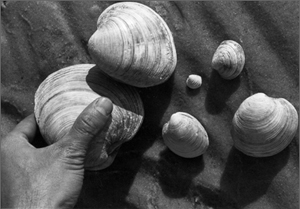The situation
 Despite
being an economic and ecological cornerstone of the South Shore Estuary
area, the hard clam has faced a precipitous harvest drop-off since the
1970s. While long recognized that this decline may be attributable to a
number of factors, some evidence suggests that the situation may be
changing further. According to Schlenk, "Observations suggest that
settlement, growth and survival may all be at an unprecedented low level
in many South Shore embayments."
Despite
being an economic and ecological cornerstone of the South Shore Estuary
area, the hard clam has faced a precipitous harvest drop-off since the
1970s. While long recognized that this decline may be attributable to a
number of factors, some evidence suggests that the situation may be
changing further. According to Schlenk, "Observations suggest that
settlement, growth and survival may all be at an unprecedented low level
in many South Shore embayments."
The response
The Hard Clam Research Initiative was launched in October 1999 to
investigate the population dynamics of hard clams in Long Island's south
shore estuary. Under the initiative, New York Sea Grant currently
administer over $425K in funds in support of hard clam research. These
monies were awarded through the Northeast Region office of the National
Oceanic and Atmospheric Administration's (NOAA) National Marine
Fisheries Service.
In December 1999, $50K was added to the Initiative’s pot for
research by the Port Authority of New York and New Jersey, which was
also supporting a hard clam stock assessment on the New Jersey side of
Raritan Bay (part of the lower New York Harbor). NYSG and SSER
contributed, respectively, an additional $100K and $50K.
How is Sea Grant and others addressing LI Sound's south shore hard clam declines?
It is anticipated that research funded under this initiative
will continue to help evaluate possible courses of action to aid in the
restoration and enhancement of the dwindling hard clam resource and its
fishery. The currently-funded suite of research now underway draws on
results from February 1999's "Workshop on Hard Clam Population Dynamics:
Research Priorities for the Shore South of Long Island," an event
co-hosted by NYSG, the South Shore Estuary Reserve (SSER), and the New
York State Department of Environmental Conservation at Danford's Inn in
Port Jefferson, NY.
Where did new funding come from to form the Hard Clam Initiative?
This effort was identified as a priority by the SSER and was
strongly supported by former Congressman Michael Forbes. A chance for
action came when the former U.S. Congressman's office contacted Sea
Grant in 1999 to see what new initiative might be developed for Long
Island's south shore.
Information was forwarded to the former Congressman, with the
suggestion that a hard clam research program could be run through NYSG
much like the Brown Tide Research Initiative model. The former
Congressman supported the idea and, with others, worked to secure the
needed monies through NOAA's National Marine Fisheries Service. While
not stated explicitly, a critical point was that the funds should be
used to answer fundamental questions about why clams are no longer
flourishing in south shore areas, not to just pay for further
transplanting, seeding, or culturing of clams. Given current conditions,
the success of such techniques was diminishing. So, supplementing those
types of efforts would not be very helpful towards dealing with the
underlying problem.
What is Sea Grant's hisory with regards to hard clam research?
It was in the late 1970's that hard clams became an intensive
topic of NYSG research and outreach. New York Sea Grant brought
malacologist Dr. Robert Malouf to New York on a Sea Grant Professorship.
Much of the Sea Grant work completed during the next decade by Malouf,
his colleagues, and their many students still stands as the best
information we have about hard clam reproduction, predation, growth, and
feeding. Additionally, to support its focus on the hard clam resource
and industry, NYSG supported and coordinated a large, multi-disciplinary
set of studies of the Great South Bay in the early 1980's. These
studies culminated in numerous journal articles, production of the
landmark The Great South Bay book, and the creation and fine-tuning of
spawner sanctuaries, aquaculture facilities, and seeding efforts.
Landings continued to decline, however, and baymen gradually moved to
other fisheries or left the water altogether. Aquaculture was not an
option the clamming industry was ready to accept.
New York Sea Grant's concern about the decline of hard clams in
the south shore bays continued, but resources to maintain further
large-scale research efforts there were not available. Single projects
were still supported as part of its core research program, however.
Additionally, in response to new developments reported by a shellfish
company representative, NYSG program development funds were used during
1998-1999 to support a pilot field study relating clam and oyster growth
to phytoplankton composition and concentration.
Looking back on the early '80s research studies, NYSG's
Assistant Director Cornelia Schlenk says the hard clam research projects
from the early '80 were a good launching pad for today's initiative.
"They gave the industry and managers much-needed knowledge," she says,
but SSER's Technical Advisory Committee felt conditions might be
evolving and that a critical re-examination and new investigations were
essential. "The SSER Council endorsed this recommendation, but did not
have the funds for its implementation," says Schlenk. "That is why this
most recent targeted allocation of federal dollars for hard clam
research could not have come at a better time."